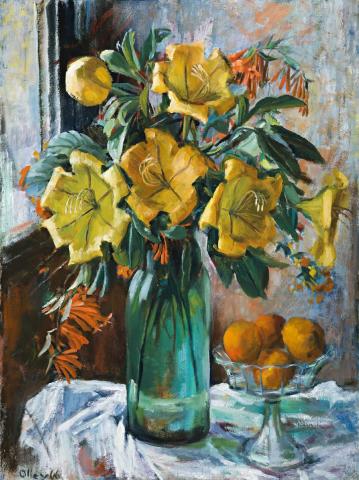SOLANDRAS, 1966
MARGARET OLLEY
oil on canvas on plywood
101.5 x 76.5 cm
signed lower left: Olley 66
signed and inscribed verso: MargareT OLLEY / 15 Morry ST / Hill End / Brisbane
The Johnstone Gallery, Brisbane (label attached verso)
Private collection, Brisbane
Margaret Olley, The Johnstone Gallery, Brisbane, 1966, cat. 9
A Time Remembered: Art in Brisbane 1950 to 1975, Queensland Art Gallery, Brisbane,18 November 1995 – 28 January 1996
Margaret Olley, Art Gallery of New South Wales, Sydney, 25 October 1996 – 5 January 1997
Queensland Art 2009, Pestorius Sweeney House, Brisbane, 2009–2010
France, C., Margaret Olley, Craftsman House, St Leonards, 1990, p. 34, pl. 11, p. 83 (illus.)
Pearce, B., Margaret Olley, Art Gallery of New South Wales, Sydney, 1996, p. 55 (illus.)
Margaret Olley: Solandras, postcard, Art Gallery of New South Wales, Sydney, 1996
France, C., Margaret Olley, Craftsman House, St Leonards, 2002, p. 46, pl. 17, p. 48 (illus.)
Pearce, B., Margaret Olley, The Beagle Press, Roseville, 2012, p. 79 (illus.)
Margaret Olley's spectacular painting Solandras was one of the key works painted during her golden period in the 1960s when she established her national reputation as a painter of floral still lives. She won the prestigious Helena Rubinstein Portrait Prize in 1962 and went on to win a spate of painting prizes including the Johnsonian Club Art Prize, Brisbane in 1964 and the Bendigo Art Prize in 1965. So prodigious was her output that she had solo exhibitions in 1964 to 1966 in Melbourne, Sydney, Newcastle, Canberra and the Johnstone Gallery, Brisbane in 1966, from which Solandras was purchased by its current owner. The stature of Solandras within Olley's oeuvre was confirmed when the work was illustrated on the gatefold postcard published in 1996 by the Art Gallery of New South Wales to announce the artist's retrospective, in which the work was featured. Solandra maxima (named after the Swedish naturalist Daniel Solander) is popularly referred to as the Golden Chalice Vine. It is from the broader family of plants known as Solanceae, which derives its name from the latin word sol meaning sun as its petals resemble the sun's rays. The vine is native to Mexico and tropical Central America like most of the Nightshade family.
Olley captures the amazing deep gold flowers characteristic of this vine in an array of intense and vibrant colour. Like many of her still life paintings ,the flower itself becomes a vessel for deeper exploration. As Christine France comments, 'Her ability to convey the essence of different flower types is unrelated to botanical description, nor does it demonstrate the exactness of seventeenth-century Dutch flower painting. In Solandras, 1966 she conveys the leathery texture and strength of the flower, but the real subject of this work is the light that ricochets off the glass bottle and compote dish mingling with the coloured flowers and fruit and reverberating through the atmosphere.'1 The light flows through the window and rests on the ample blooms of the Solandra plant thus capturing a moment in time and highlighting the transient beauty of nature and the cycle of life evinced in the ripe fruit sitting in the glass compote to the right. The scene has all the ethereal quality found in the works of the French still life artist and Olley's adored mentor, Pierre Bonnard.
1. France, C., Margaret Olley, Craftsman House, St Leonards, 2002, p. 46
